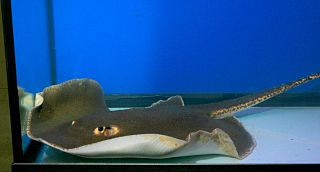
The roughback whipray is a rare species of freshwater stingray in the family Dasyatidae, found over sandy bottoms in the Mae Klong and Chao Phraya Rivers of Thailand. Growing no more than 29 cm (11 in) across, this small ray has an oval pectoral fin disc and a whip-like tail without fin folds. It closely resembles the white-edge freshwater whipray in appearance, but can be distinguished by its coloration: light gray to dark orange-brown above and white below with a dark band along the lateral margins. Another identifying feature is a "pearl organ" at the center of the back, found in individuals of all ages. All of the original specimens of the roughback whipray were found with extensive wounds to the fins and tail. The International Union for Conservation of Nature (IUCN) has assessed this species as Endangered, citing the extensive habitat degradation and heavy fishing pressure within its limited range.

The speartooth shark is a rare species of river shark, belonging to the family Carcharhinidae. It inhabits coastal marine waters and tidal reaches of large tropical rivers in northern Australia and New Guinea. Despite being a member of the river shark genus, it is also found in near-shore marine waters, favoring highly turbid environments over a wide range of salinities. This robustly built, gray-colored shark is characterized by a short and broad snout, tiny eyes, a relatively large second dorsal fin, and a black blotch beneath each pectoral fin near the tip. Another identifying trait is its teeth, which are large, triangular, and serrated in the upper jaw and narrow, spear-like, and serrated only near the tips in the lower jaw. Adults grow to about 2.6 m (8.5 ft) long.
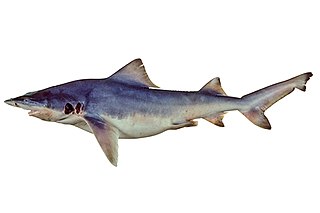
The northern river shark or New Guinea river shark is a species of requiem shark, in the family Carcharhinidae, found in scattered tidal rivers and associated coastal waters in northern Australia and in Papua New Guinea. This species inhabits areas with poor visibility, soft bottoms, and large tides, with immature sharks ranging into fresh and brackish water. It is similar to other river sharks in having a stocky grey body with a high back, tiny eyes, and broad fins. It measures up to 2.5 m (8.2 ft) long.
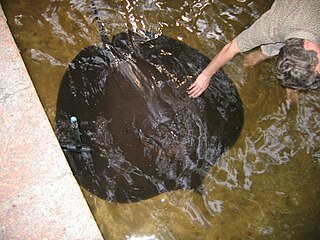
The giant freshwater stingray is a species of stingray in the family Dasyatidae. It is found in large rivers and estuaries in Southeast Asia and Borneo, though historically it may have been more widely distributed in South and Southeast Asia. The largest freshwater fish and the largest stingray in the world, this species grows up to 2.2 m (7.2 ft) across and can reach up to 300 kg (660 lb) in weight. It has a relatively thin, oval pectoral fin disc that is widest anteriorly, and a sharply pointed snout with a protruding tip. Its tail is thin and whip-like, and lacks fin folds. This species is uniformly grayish brown above and white below; the underside of the pectoral and pelvic fins bear distinctive wide, dark bands on their posterior margins.

Himantura is a genus of stingray in the family Dasyatidae that is native to the Indo-Pacific. In a 2016 taxonomic revision, many of the species formerly assigned to Himantura were reassigned to other genera.

The red-headed myzomela or red-headed honeyeater is a passerine bird of the honeyeater family Meliphagidae found in Australia, Indonesia, and Papua New Guinea. It was described by John Gould in 1840. Two subspecies are recognised, with the nominate race M. e. erythrocephala distributed around the tropical coastline of Australia, and M. e. infuscata in New Guinea. Though widely distributed, the species is not abundant within this range. While the IUCN lists the Australian population of M. e. infuscata as being near threatened, as a whole the widespread range means that its conservation is of least concern.
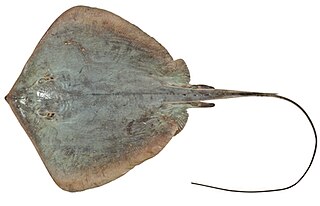
The estuary stingray, also called the estuary stingaree or brown stingray, is a species of stingray in the family Dasyatidae. Endemic to eastern Australia, it typically inhabits shallow, mangrove-lined tidal rivers, estuaries, and bays in southern Queensland and New South Wales. This yellow-brown to olive ray grows to at least 93 cm (37 in) across. It has a diamond-shaped pectoral fin disc and a mostly smooth, whip-like tail bearing both dorsal and ventral fin folds. It can additionally be identified by its long, narrow nostrils and the row of thorns along the midline of its back.
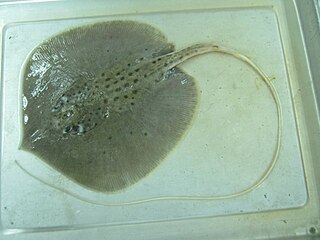
The white-edge freshwater whipray is an extremely rare species of stingray in the family Dasyatidae, native to four river systems in Southeast Asia. Measuring up to 60 cm (24 in) across, this ray has an oval pectoral fin disc and a very long, whip-like tail without fin folds. It can be identified by the presence of a sharply delineated white band running around the margin of its otherwise brown disc, as well as by its white tail and a band of dermal denticles along the middle of its back. This species feeds on benthic invertebrates and is aplacental viviparous. Its two long tail spines are potentially dangerous to humans. The International Union for Conservation of Nature (IUCN) has assessed the white-edge freshwater whipray as Endangered, as it is under heavy pressure from fishing and habitat loss, degradation, and fragmentation.

Urogymnus is a genus of stingrays in the family Dasyatidae from marine, brackish and freshwater habitats in the Indo-Pacific and tropical East Atlantic regions. The genus was previously considered to be monotypic, containing only the porcupine ray. Molecular phylogenetic research published in 2016 reassigned several species from Himantura to Urogymnus.

The mangrove whipray or whitetail stingray, is a species of stingray in the family Dasyatidae. It is widely distributed in the Indo-Pacific region from the Red Sea to northern Australia and Micronesia. A benthic inhabitant of shallow inshore waters, juvenile mangrove whiprays favor mangrove and estuarine habitats, while adults favor sandy to rocky areas in lagoons and coral reefs. This species can be identified by its thick, oval pectoral fin disc that is dark gray above with numerous white flecks, and by its relatively short, whip-like tail that is white past the stinging spine. It grows up to 1.4 m (4.6 ft) across.

The pink whipray is a species of stingray in the family Dasyatidae, with a wide but ill-defined distribution in the tropical Indo-Pacific from southern Africa to Polynesia. It is a bottom dweller that generally inhabits shallow water under 70 m (230 ft) deep, in sandy areas associated with coral reefs. Individuals exhibit a high degree of fidelity to particular locations. The pink whipray has a diamond-shaped pectoral fin disc wider than long, with a broad-angled snout and a very long, whip-like tail without fin folds. It has only a few small thorns on its back and is uniform brownish to grayish pink in color, becoming much darker past the tail sting. This large ray can reach 1.8 m (5.9 ft) across and over 5 m (16 ft) long.

The Jenkins' whipray is a species of stingray in the family Dasyatidae, with a wide distribution in the Indo-Pacific region from South Africa to the Malay Archipelago to northern Australia. This large species grows to 1.5 m (4.9 ft) across and has a broad, diamond-shaped pectoral fin disc and a whip-like tail without fin folds. It has a band of heart-shaped dermal denticles running from between the eyes to the tail on its upper surface, along with a characteristic row of large spear-like thorns along the midline. It is uniform yellowish brown above, becoming grayish on the tail past the stinging spine, and white below; there is apparently a spotted color variant that had previously been described as a different species, the dragon stingray.
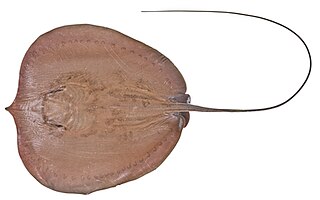
The freshwater whipray is a little-known species of stingray in the family Dasyatidae, found in a number of large rivers and associated estuaries in northern Australia. Until recently, this species was regarded as a regional subpopulation of the similar-looking but much larger giant freshwater stingray of Southeast Asia. Typically reaching 1 m (3.3 ft) across, the freshwater whipray has a distinctively shaped, rounded pectoral fin disc, a projecting snout, and a thin tail without fin folds. It is plain brown above and white below with dark marginal bands. It may occasionally travel onto land and can "breathe" out of water for up to 7 minutes. The freshwater whipray is an active hunter of small fishes and shrimps, and does not currently face substantial conservation threats.
The tubemouth whipray is a little-known species of stingray in the family Dasyatidae, named for its distinctive, highly protrusible jaws. It is found in shallow, brackish water near mangrove forests and large river mouths along the coasts of southwestern Borneo and southern Sumatra. Measuring up to 1 m (3.3 ft) across, this species has a diamond-shaped pectoral fin disc with an elongated, pointed snout and broadly rounded outer corners. The upper surface of the disc is a plain grayish or brownish in color, and covered by small, flattened dermal denticles. The tubemouth whipray is relatively common at present, but is heavily pressured by habitat degradation and coastal fisheries. The International Union for Conservation of Nature (IUCN) has listed it as Vulnerable.
The Hortle's whipray is a little-known species of stingray in the family Dasyatidae, occurring in shallow estuaries and mud flats off southern New Guinea. This species, growing to 71 cm (28 in) across, has a heart-shaped pectoral fin disc with a long, pointed snout and minute eyes. It has a wide dorsal band of dermal denticles extending from in front of the eyes to the tail, as well as scattered sharp denticles on the snout. The underside of the disc is a distinctive bright yellow in color, sometimes with darker markings around the nostrils, mouth, and gill slits. The Hortle's whipray is threatened by extensive seine fisheries and habitat degradation, leading the International Union for Conservation of Nature (IUCN) to assess it as Near Threatened.

The black-spotted whipray is a species of stingray in the family Dasyatidae, found in the coastal waters off southern New Guinea and northern Australia. Long thought to be a variant of the related brown whipray, this species has an angular, diamond-shaped pectoral fin disc and a whip-like tail without fin folds. It is characterized by its dorsal color pattern, which consists of a variably extensive covering of small, close-set dark, and sometimes also white spots, on a grayish-brown background. In addition, the tail has alternating light and dark saddles past the stinging spine. This species reaches a maximum recorded width of 80 cm (31 in).
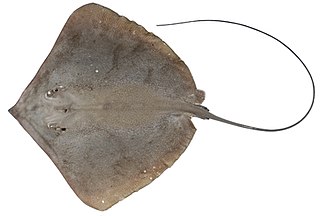
The brown whipray is a species of stingray in the family Dasyatidae, common in inshore, muddy habitats along the northern coast of Australia. It has often been confused in literature for the honeycomb stingray and the black-spotted whipray, which until recently was thought to be the same species. This species has an angular, diamond-shaped pectoral fin disc and a long, very thin tail without fin folds. It is plain brown above, sometimes with white dots or flecks near the edge of the disc, and white below; the tail is dark all over, with alternating dark and light bands near the tip. The maximum recorded disc width is 74 cm (29 in).

The blackedge whipray is a little-known species of stingray in the family Dasyatidae, found in the coastal waters of the Bay of Bengal and the Gulf of Mannar. Attaining a disc width of 1.8 m (5.9 ft), this species has a diamond-shaped disc with two small concavities on either side of the snout tip, and a long, whip-like tail without tail folds. It is characterized by large thorns with star-shaped bases scattered over the disc, and by the wide, black marginal bands on the underside of the disc. The International Union for Conservation of Nature (IUCN) currently lacks sufficient data to assess the blackedge whipray beyond Data Deficient.

The leopard whipray is a little-known species of stingray in the family Dasyatidae, found in the Indian and Pacific Oceans from the Andaman Sea to the Coral Triangle. It is found close to shore at depths shallower than 70 m (230 ft), over soft substrates. Attaining a width of 1.8 m (5.9 ft), this species has a diamond-shaped pectoral fin disc with a pointed snout and an extremely long, whip-like tail without fin folds. Adult rays have a leopard-like dorsal pattern of dark brown rings on a yellowish brown background, as well as a row of enlarged, heart-shaped dermal denticles along the midline of the disc. Newborns and small juveniles have large, solid dark spots and few denticles. The leopard whipray is caught by fisheries in many parts of its range, primarily for meat.
Acanthobothrium zimmeri is a species of tapeworm named after the author Carl Zimmer. A. zimmeri was first described in 2009 based on specimens collected from the Arafura Sea in Australia's Northern Territory. It parasitizes a species of stingray in the genus Himantura. It has also been found to parasite Urogymnus acanthobothrium.


















